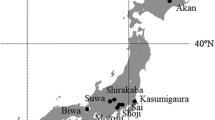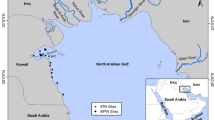Abstract
To investigate the long-term trend of light conditions in Lake Kasumigaura (a shallow eutrophic lake with high turbidity) in Japan, 215 images of MERIS data from the period 2003–2012 were processed at four stations using a semi-analytical algorithm to retrieve their inherent optical properties after atmospheric correction. Previously obtained Secchi depths (SDs) were somewhat underestimated by the proposed algorithms, and the ratio of the predicted SD to the measured SD changed with the ratio of tripton to chlorophyll a. A submodel was then built describing the ratio of scattering to backscattering based on the ratio of tripton to chlorophyll a (a trend supported by a number of previous reports) and applied to the prediction of SD in this lake. The model showed a gradually increasing trend at all stations in the predicted SD over the period, which was validated by the observations. The relationship between the measured and predicted SDs within a 2-day period was scattered, but showed a positive correlation at a significant level. In addition, this proposed method with the submodel describing the ratio of scattering to backscattering was applied to in situ reflectance spectra, and a correlation at a significant level was confirmed between the measured and predicted SDs.







Similar content being viewed by others
References
Arai H, Fukushima T (2014) Impacts of long-term increase in silicon concentration on diatom blooms in Lake Kasumigaura, Japan. Int J Limnol 50:335–346
Arai H, Fukushima T, Komatsu K (2012) Increase in silicon concentrations and release from suspended solids and bottom sediments in Lake Kasumigaura, Japan. Limnology 13(1):81–95
Bailey SW, Werdell PJ (2006) A multi-sensor approach for the on-orbit validation of ocean color satellite data products. Remote Sens Environ 102:12–23
Bowers DG, Hill PS, Braithwaite KM (2014) The effect of particulate organic content on the remote sensing of marine suspended sediments. Remote Sens Environ 144:172–178
Chen Z, Muller-Karger FE, Hu C (2007) Remote sensing of water clarity in Tampa Bay. Remote Sens Environ 109(2):249–259
Davies-Colley RJ (1988) Measuring water clarity with a black disc. Limnol Oceanogr 33(4):616–623
Doron M, Babin M, Mangin A, Hembise O (2007) Estimation of light penetration, and horizontal and vertical visibility in oceanic and coastal waters from surface reflectance. J Geophys Res Oceans 112(C6):C06003
Doron M, Babin M, Hembise O, Mangin A, Garnesson P (2011) Ocean transparency from space: validation of algorithms using MERIS, MODIS and SeaWiFS data. Remote Sens Environ 115(12):2986–3001
ESA’s Link to Earth Observation (EOLi) (2014) Available online: http://earth.esa.int/EOLi/EOLi.html. Accessed on 1 March 2014
Fukushima T, Arai H (2015) Regime shifts observed in Lake Kasumigaura, a large shallow lake in Japan: analysis of a 40-year limnological record. Lakes Reserv Res Manag 20(1):54–68
Fukushima T, Kawamura S, Seki T, Onda Y, Imai A, Matsushige K (2005) Why has Lake Kasumigaura become turbid? In: Jones J (ed) International association of theoretical and applied limnology, proceedings 29:732–737
Fukushima T, Matsushita B, Oyama Y, Yoshimura K, Yang W, Terrel M, Kawamura S, Takegahara A (2016) Semi-analytical prediction of Secchi depth using remote-sensing reflectance for lakes with a wide range of turbidity. Hydrobiologia 780(1):5–20
Gordon HR, Wang MH (1994) Retrieval of water-leaving radiance and aerosol optical thickness over the oceans with SeaWiFS: a preliminary algorithm. Appl Opt 33(3):443–452
Han L, Jordan KJ (2005) Estimating and map** chlorophyll-a concentration in Pensacola Bay, Florida, using Landsat ETM + data. Int J Remote Sens 26:5245–5254
IOCCG (2006) Remote sensing of inherent optical properties: fundamentals, tests of algorithms, and applications. In: Lee ZP (ed) Reports of the International Ocean-Colour Coordinating Group No. 5. Dartmouth, NS
Ishikawa T, Tanaka M, Koseki M (1989) On the influence of diurnal stratification on water quality in a shallow lake. J JSCE 411/II-12:247–254 (In Japanese with an English abstract)
Jaelani LM, Matsushita B, Yang W, Fukushima T (2015) An improved atmospheric correction algorithm for applying MERIS data to very turbid inland waters. Int J Appl Earth Obs 39:128–141
Kirk JTO (1984) Dependence of relationship between inherent and apparent optical properties of water on solar altitude. Limnol Oceanogr 29(2):350–356
Koenings JP, Edmundson JA (1991) Secchi disk and photometer estimates of light regimes in Alaskan lakes: effects of yellow color and turbidity. Limnol Oceanogr 36(1):91–105
Koponen S, Pulliainen J, Kallio K, Hallikainen M (2002) Lake water quality classification with airborne hyperspectral spectrometer and simulated MERIS data. Remote Sens Environ 79(1):51–59
Lee ZP, Du KP, Arnone R (2005) A model for the diffuse attenuation coefficient of downwelling irradiance. J Geophys Res Oceans 110:C02016
Lee ZP, Lubac B, Werdell J, Arnone R (2009) An update of the quasi-analytical algorithm (QAA_v5). Available online: http://www.ioccg.org/groups/Software_OCA/QAA_v5.pdf]. Accessed on 20 Oct 2014
Loisel H, Meriaux X, Berthon J-F, Poteau A (2007) Investigation of the optical backscattering to scattering ratio of marine particles in relation to their biogeochemical composition in the eastern English Channel and southern North Sea. Limnol Oceanogr 52(2):739–752
Mancino G, Nole A, Urbano V, Amato M, Ferrara A (2009) Assessing water quality by remote sensing in small lakes: the case study of Monticchio lakes in southern Italy. Iforest Biogeosci For 2:154–161
Matsushita B, Jaelani LM, Yang W, Oyama Y, Fukushima T (2015) Long-term monitoring of chlorophyll-a concentration in Lake Kasumigaura using MERIS data. J Remote Sens Soc Jpn 35(3):129–139 (in Japanese with English abstract)
Mobley CD, Gentili B, Gordon HR, ** ZH, Kattawar GW, Morel A, Reinersman P, Stamnes K, Stavn RH (1993) Comparison of numerical models for computing underwater light fields. Appl Opt 32(36):7484–7504
Morel A (1974) Optical properties of pure water and pure sea water. In: Jerlov NG, Steeman E (eds) Optical aspects of oceanography. Academic, London, pp 1–24
Muraoka K, Fukushima T (1986) On the box model for prediction of water quality in eutrophic lakes. Ecol Model 31(1–4):221–236
Nakamura K, Aizaki M (2016) Effect of suspended solid on light attenuation in the shallow and turbid Lake Kasumigaura, Japan: long-term variation of the light attenuation mechanism. Jpn J Limnol 77:13–23 (in Japanese with English abstract)
National Institute for Environmental Studies (2016) Lake Kasumigaura Database, National Institute for Environmental Studies, Japan. Available online: http://db.cger.nies.go.jp/gem/moni-e/inter/GEMS/database/kasumi/index.html. Accessed on 1 March 2016
Nelson SAC, Soranno PA, Cheruvelil KS, Batzli S, Skole DL (2003) Regional assessment of lake water clarity using satellite remote sensing. J Limnol 62(supple. 1):27–32
Preisendorfer RW (1986) Secchi disc science—visual optics of natural waters. Limnol Oceanogr 31(5):909–926
SeaWiFS Data Analysis System (2016) available online: https://seadas.gsfc.nasa.gov/. Accessed on 1 March 2016
Seki T, Fukushima T, Imai A, Matsushige K (2006) Turbidity increase and sediment resuspension in Lake Kasumigaura. J JSCE 811/VII-38:149–161 (In Japanese with an English abstract)
Shi K, Li Y, Zhang Y, Li L, Lv H, Song K (2014) Optical scattering properties of organic-rich and inorganic-rich particles in inland waters. J Great Lakes Res 40(2):308–316
Takami S (2011) Light measurement in ecological studies. Clim Biosph 11:A1–A7 (in Japanese)
Terrel MM, Fukushima T, Matsushita B, Yoshimura K, Imai A (2012) Long-term light environment variability in Lake Biwa and Lake Kasumigaura, Japan: modeling approach. Limnology 13:237–252
Twardowski MS, Boss E, Macdonald JB, Pegau WS, Barnard AH, Zaneveld JRV (2001) A model for estimating bulk refractive index from the optical backscattering ratio and the implications for understanding particle composition in case I and case II waters. J Geophys Res Ocean 106(C7):14129–14142
Tyler JE (1968) Secchi depth. Limnol Oceanogr 13(1):1–6
Whitmire AL, Boss E, Cowles TJ, Pegau WS (2007) Spectral variability of the particulate backscattering ratio. Opt Express 15(11):7019–7031
Yang W, Matsushita B, Chen J, Fukushima T (2011) Estimating constituent concentrations in case II waters from MERIS satellite data by semi-analytical model optimizing and look-up tables. Remote Sens Environ 115(5):1247–1259
Yang W, Matsushita B, Chen J, Yoshimura K, Fukushima T (2013) Retrieval of inherent optical properties for turbid inland waters from remote-sensing reflectance. IEEE Trans Geosci Remote 51(6):3761–3773
Yang W, Matsushita B, Chen J, Yoshimura K, Fukushima T (2014) Application of a semi-analytical algorithm to remotely estimate diffuse attenuation coefficient in turbid inland waters. IEEE Geosci Remote Sci 11(6):1046–1050
Yang W, Matsushita B, Yoshimura K, Chen J, Fukushima T (2015) A modified semi-analytical algorithm for remotely estimating euphotic zone depth in turbid inland waters. IEEE J Sel Top Appl 8(4):1545–1554
Acknowledgements
This research was supported in part by Grants-in-Aid for Scientific Research from the Ministry of Education, Culture, Sport, Science and Technology (MEXT), Japan (Nos. 23404015 and 26281039), the Global Environment Research Fund (S9-4) of the Ministry of Environment, Japan, and the River Fund (27-1271-001) in charge of The River Foundation, Japan. Monitoring data on SD were provided by the National Institute for Environmental Studies (NIES). We express our appreciation to 2 anonymous reviewers for constructive criticisms on earlier versions of the manuscript.
Author information
Authors and Affiliations
Corresponding author
Ethics declarations
Conflict of interest
The authors declare that they have no conflict of interest.
Additional information
Handling Editor: Hidekatsu Yamazaki.
Electronic supplementary material
Below is the link to the electronic supplementary material.
Rights and permissions
About this article
Cite this article
Fukushima, T., Matsushita, B., Yang, W. et al. Semi-analytical prediction of Secchi depth transparency in Lake Kasumigaura using MERIS data. Limnology 19, 89–100 (2018). https://doi.org/10.1007/s10201-017-0521-3
Received:
Accepted:
Published:
Issue Date:
DOI: https://doi.org/10.1007/s10201-017-0521-3




